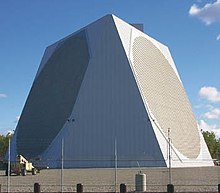Early-warning radar

An early-warning radar is any radar system used primarily for the long-range detection of its targets, i.e., allowing defences to be alerted as early as possible before the intruder reaches its target, giving the air defences the maximum time in which to operate. This contrasts it with systems used primarily for tracking or gun laying, which tend to be shorter range but offer much higher accuracy.
History
The first early-warning radars were the British Chain Home, the US CXAM (Navy) and SCR-270 (Army), and the German Freya. By modern standards these were quite short range, typically about 100 to 150 miles (160 to 240 km). This "short" distance is a side effect of radio propagation at the long wavelengths being used at the time, which were generally limited to line-of-sight. Although techniques for long-range propagation were known and widely used for shortwave radio, the ability to process the complex return signal was simply not possible at the time.
Cold War
Starting in the 1950s, a number of over-the-horizon radars were developed that greatly extended detection ranges, generally by bouncing the signal off the ionosphere. Perhaps the most capable of these systems was the DEW Line, although other examples have since been built with even better performance. An alternative early warning design was the McGill Fence, which provided "line breaking" indication across the middle of Canada, with no provision to identify the target's exact location or direction of travel.
Modern day
Today the early warning role has been supplanted to a large degree by airborne early warning platforms. By placing the radar on an aircraft, the line-of-sight to the horizon is greatly extended. This allows the radar to use high-frequency signals, offering high resolution, while still offering long range. A major exception to this rule are radars intended to warn of ballistic missile attacks, like BMEWS, as the high-altitude exo-atmospheric trajectory of these weapons allows them to be seen at great ranges even from ground-based radars.
Early systems
1950s through 70s
- Pinetree Line
- McGill Fence
- Distant Early Warning Line
- Duga-3
- BMEWS
- Radar Type 80
- ROTOR
- Oko
- Dnistr
- Dnepr
- Daryal
- Linesman/Mediator

